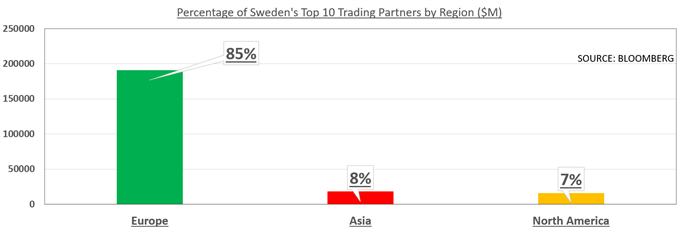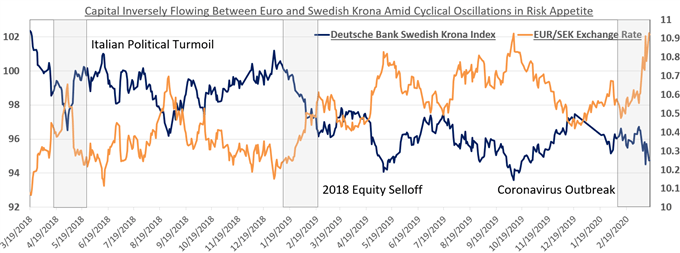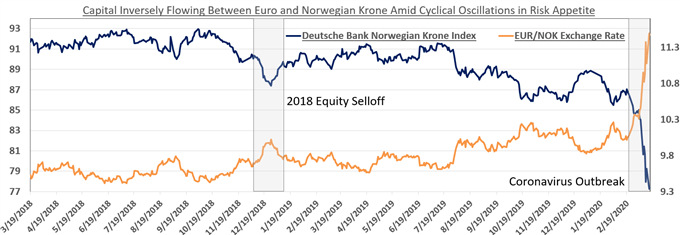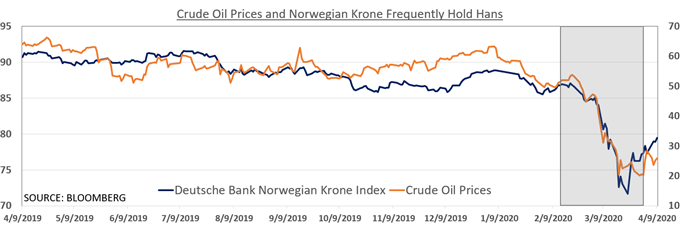Euro Analysis, Eurozone Economy, Swedish Krona, Norwegian Krone, Understanding the Core-Perimeter Model – TALKING POINTS
- How to trade the Euro against the Swedish Krona and Norwegian Krone
- What are the economic and trade relations between the Eurozone, Sweden and Norway?
- How the relationship between Sweden, Norway and EU fits into the Core-Perimeter model
The business cycle sensitivity of Nordic assets, which makes them riskier but also offers higher rates of return, tends boost their appeal relative to safer EU-based counterparts in an optimistic market environment. This typically results in a weaker Euro/Nordic exchange rate because investors are prioritizing profits over capital preservation. This flow of capital is underpinned by the interconnected economic network that the Eurozone, Norway and Sweden all share.
The Sweden and Norway-EU Relationship: Trade, Economics and the EUR/SEK, EUR/NOK Rate
An overwhelming majority of Swedish and Norwegian exports flow to the heart of Europe. Therefore, when investors are buoyant and have a positive outlook on growth, this trading relationship leads to capital running from the core (EU) to perimeter (Nordic) countries. Robust demand from Europe is a crucial source of economic vitality for the outward-facing Scandinavian economies.
European Demand: A Key Destination for Norwegian Exports (2018)

European Demand: A Key Destination for Swedish Exports (2018)

However, during an economic downturn, the direction of capital flows reverses. This frequently results in a stronger Euro/Nordic exchange rate as investors turn more risk-averse and reduce their exposure to riskier assets (such as NOK and SEK). In this regard, the stability and strength of the Eurozone acts as a magnet for investors with capital looking to hold it where it will be comparatively less exposed to volatility.
Even if the Eurozone itself is the epicenter of market turmoil, traders typically prefer to hold their capital in German Bunds or the Euro over their Nordic counterparts. To put it another way: capital flows from perimeter to core in a ‘risk-off’ scenario. In the example below, the EUR/SEK exchange rate strengthened between 2018 and 2019 as political risk in Europe drove the Euro higher because it was viewed as comparatively safer than the Swedish Krona.
Capital Shifts from Perimeter (SEK) to Core (EUR) Assets Amid Market-Wide Risk Aversion

Conversely, as the global economy began to recover from the 2008 global financial crisis, the EUR/SEK exchange rate weakened as risk appetite was revived and traders felt more optimistic about the overall growth outlook. Investors then started to redirect their capital away from the oasis of security in the core (EU) to the comparatively riskier but higher-returning alternatives in the perimeter (Nordics). This relationship reflected a resurrected interest in trading riskier and higher-yielding assets in a less uncertain environment.
Capital Shifts from Perimeter (NOK) to Core (EUR) Assets Amid Market-Wide Risk Aversion

Crude Oil Prices and the Norwegian Krone: What is the Connection?
The Norwegian Krone in particular is susceptible to fluctuations in risk appetite due to Norway’s strong connection to the petroleum industry. As a cycle-sensitive commodity, crude oil prices quickly respond to changes in global sentiment because of what that could mean for future demand of a key input in economic growth. NOK, in this regard, is frequently at the mercy of the same forces that influence the commodity.
Norwegian Krone Index and Brent – Daily Chart

Key Takeaways on How to Trade the EU-Nordic Currencies
- The Core-Perimeter model shows that during times of uncertainty, capital typically flows from the perimeter economies (Norway and Sweden) into the core (Eurozone)
- This frequently results in the Euro strengthening vs the Norwegian Krone and Swedish Krona
- Conversely, when risk appetite is high, the comparatively safer Euro typically weakens against relatively riskier Nordic FX as capital flows out of the Eurozone (core) and into the perimeter (Scandinavian countries)
- NOK and SEK are tied to export-oriented economies whose outward-facing nature makes them vulnerable to global gyrations in market mood
MORE MACRO FOREX TRADING GUIDES IN THIS SERIES
- Relationship Between Core and Perimeter Countries
- China-ASEAN Relations and How it Influences SGD, IDR, MYR, PHP
- How US-Canada Trade Relations Impact CAD and USD
- China-New Zealand and Australia Relations: Trading AUD & NZD
- How US-Mexico Relations Influence the Mexican Peso and US Dollar
--- Written by Dimitri Zabelin, Currency Analyst for DailyFX.com
To contact Dimitri, use the comments section below or @ZabelinDimitri on Twitter


